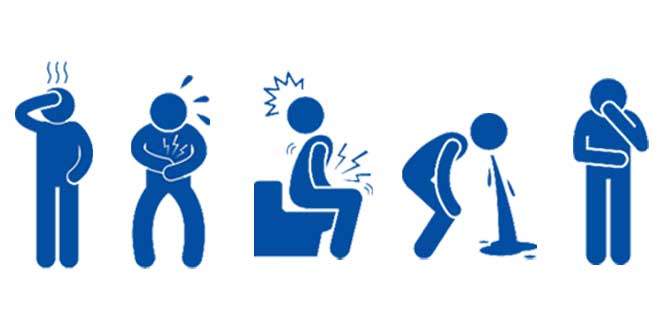
Overview
Also known as food-borne illness, food poisoning is determined by eating contaminated, toxic or spoiled food. The most common infectious organisms are viruses, parasites Related post and bacteria or their toxins. These infectious organisms or their toxins can contaminate food at any point of processing or production. Contamination can also appear at home if food is not correctly handled or cooked.
Usually, the symptoms of food poisoning can start within hours of eating the contaminated food and they include vomiting, diarrhea or nausea. You don’t need to panic because food poisoning is often mild and resolves without a certain treatment.
Signs and Symptoms
The symptoms of food-borne illness are various depending on the source of contamination, but most types of food poisoning can cause one, maybe more of the following signs and symptoms:
-
-
- Abdominal cramps
- Nausea
- Vomiting
- Diarrhea
-
As we said, these signs may appear within hours after eating the contaminated food or even after a couple of days. The sickness which is caused by food-borne illness generally lasts from a few hours to several days. However, its symptoms can get worse and you can experience the followings:
-
-
- Blood in the stool or vomit
- Dehydration
- High fevers
- Diarrhea that lasts more than 3 days
- Headaches
- Weakness
- Blurry vision Related post
- Numb, tingling, or burning sensations in the extremities
- Bloating
- Liver problems
- Renal problems
- Reactive arthritis
- Seizures
-
When to see a doctor
As we said, food poisoning is often mild, so you don’t have to worry about it, but if you experience any of the following signs you should visit your doctor as soon as possible for medical attention.
-
-
- Frequent episodes of vomiting and inability to keep liquids down
- Bloody vomit or stools
- Diarrhea for more than three days
- Extreme pain or severe abdominal cramping
- An oral temperature higher than 100.4 F (38 C)
- Signs or symptoms of dehydration — excessive thirst, dry mouth, little or no urination, severe weakness, dizziness, or lightheadedness
- Neurological symptoms such as blurry vision, muscle weakness and tingling in the arms
-
Causes
Contamination can occur at any moment of production—while growing, harvesting, processing, storing, shipping or preparing. The most common cause is cross-contamination which is actually the transfer of harmful organisms from one surface to another one. Ready-to-eat foods such as salads are often contaminated, because they aren’t cooked. There are many dangers that could cause food-borne illness.
The table below will show you some of the most common contaminants; when you may start to feel the symptoms and common ways the organism is spread.
| Contaminant | Onset of symptoms | Foods affected and means of transmission |
|---|---|---|
| Campylobacter | 2 to 5 days | Meat and poultry. Contamination occurs during processing if animal feces contact meat surfaces. Other sources include unpasteurized milk and contaminated water. |
| Clostridium botulinum | 12 to 72 hours | Home-canned foods with low acidity, improperly canned commercial foods, smoked or salted fish, potatoes baked in aluminum foil, and other foods kept at warm temperatures for too long. |
| Clostridium perfringens | 8 to 16 hours | Meats, stews and gravies. Commonly spread when serving dishes don’t keep food hot enough or food is chilled too slowly. |
| Escherichia coli (E. coli) O157:H7 | 1 to 8 days | Beef contaminated with feces during slaughter. Spread mainly by undercooked ground beef. Other sources include unpasteurized milk and apple cider, alfalfa sprouts, and contaminated water. |
| Giardia lamblia | 1 to 2 weeks | Raw, ready-to-eat produce and contaminated water. Can be spread by an infected food handler. |
| Hepatitis A | 28 days | Raw, ready-to-eat produce and shellfish from contaminated water. Can be spread by an infected food handler. |
| Listeria | 9 to 48 hours | Hot dogs, luncheon meats, unpasteurized milk and cheeses, and unwashed raw produce. Can be spread through contaminated soil and water. |
| Noroviruses (Norwalk-like viruses) | 12 to 48 hours | Raw, ready-to-eat produce and shellfish from contaminated water. Can be spread by an infected food handler. |
| Rotavirus | 1 to 3 days | Raw, ready-to-eat produce. Can be spread by an infected food handler. |
| Salmonella | 1 to 3 days | Raw or contaminated meat, poultry, milk, or egg yolks. Survives inadequate cooking. Can be spread by knives, cutting surfaces or an infected food handler. |
| Shigella | 24 to 48 hours | Seafood and raw, ready-to-eat produce. Can be spread by an infected food handler. |
| Staphylococcus aureus | 1 to 6 hours | Meats and prepared salads, cream sauces, and cream-filled pastries. Can be spread by hand contact, coughing and sneezing. |
| Vibrio vulnificus | 1 to 7 days | Raw oysters and raw or undercooked mussels, clams, and whole scallops. Can be spread through contaminated seawater. |
Risk factors
-
-
- People with chronic disease. Your immune response is reduced if you have a chronic condition such as liver disease, diabetes Related post or AIDS. Also, receiving radiation therapy for cancer could be a risk factor.
- Older adults. When you get older, the immune system is not as effective as it should be to infectious organisms.
- Infants and young children. When it comes to infants and food poisoning, their immune systems haven’t fully developed, that’s why they are part of the high-risk groups.
- Pregnant women. When you are pregnant, your changes in circulation and metabolism can maximize the risk of food poisoning.
- People with chronic disease. Your immune response is reduced if you have a chronic condition such as liver disease, diabetes Related post or AIDS. Also, receiving radiation therapy for cancer could be a risk factor.
-
Prevention
-
-
- Wash your hands, utensils and food surfaces often.
- Keep raw foods separate from ready-to-eat foods.
- Refrigerate or freeze perishable foods as soon as possible.
- Defrost food safely.
- Throw your food out when in doubt.
-

























